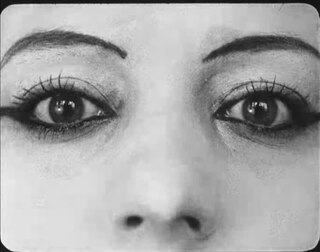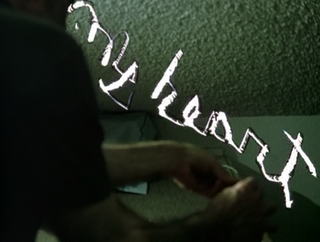Related Research Articles

35 mm film is a film gauge used in filmmaking, and the film standard. In motion pictures that record on film, 35 mm is the most commonly used gauge. The name of the gauge is not a direct measurement, and refers to the nominal width of the 35 mm format photographic film, which consists of strips 1.377 ± 0.001 inches (34.976 ± 0.025 mm) wide. The standard image exposure length on 35 mm for movies is four perforations per frame along both edges, which results in 16 frames per foot of film.

The Kinetoscope is an early motion picture exhibition device, designed for films to be viewed by one person at a time through a peephole viewer window. The Kinetoscope was not a movie projector, but it introduced the basic approach that would become the standard for all cinematic projection before the advent of video: it created the illusion of movement by conveying a strip of perforated film bearing sequential images over a light source with a high-speed shutter. First described in conceptual terms by U.S. inventor Thomas Edison in 1888, it was largely developed by his employee William Kennedy Laurie Dickson between 1889 and 1892. Dickson and his team at the Edison lab in New Jersey also devised the Kinetograph, an innovative motion picture camera with rapid intermittent, or stop-and-go, film movement, to photograph movies for in-house experiments and, eventually, commercial Kinetoscope presentations.

Roller chain or bush roller chain is the type of chain drive most commonly used for transmission of mechanical power on many kinds of domestic, industrial and agricultural machinery, including conveyors, wire- and tube-drawing machines, printing presses, cars, motorcycles, and bicycles. It consists of a series of short cylindrical rollers held together by side links. It is driven by a toothed wheel called a sprocket. It is a simple, reliable, and efficient means of power transmission.

A movie projector is an opto-mechanical device for displaying motion picture film by projecting it onto a screen. Most of the optical and mechanical elements, except for the illumination and sound devices, are present in movie cameras. Modern movie projectors are specially built video projectors.

Experimental film or avant-garde cinema is a mode of filmmaking that rigorously re-evaluates cinematic conventions and explores non-narrative forms or alternatives to traditional narratives or methods of working. Many experimental films, particularly early ones, relate to arts in other disciplines: painting, dance, literature and poetry, or arise from research and development of new technical resources.
Structural film was an avant-garde experimental film movement prominent in the United States in the 1960s and which developed into the Structural/materialist films in the United Kingdom in the 1970s.

Film perforations, also known as perfs and sprocket holes, are the holes placed in the film stock during manufacturing and used for transporting and steadying the film. Films may have different types of perforations depending on film gauge, film format, and intended usage. Perforations are also used as a standard measuring reference within certain camera systems to refer to the size of the frame.
George Landow, also known as Owen Land, was a painter, writer, photographer and experimental filmmaker. He also worked under the pen names Orphan Morphan and Apollo Jize.

Flaming Creatures is a 1963 American experimental film directed by Jack Smith. The film follows an ensemble of drag performers through several disconnected vignettes, including a lipstick commercial, an orgy, and an earthquake. It was shot on a rooftop on the Lower East Side on a very low budget of only $300, with a soundtrack from Smith's roommate Tony Conrad. It premiered April 29, 1963 at the Bleecker Street Cinema in Greenwich Village.
Optical manufacturing and testing is the process of manufacturing and testing optical components. It spans a wide range of manufacturing procedures and optical test configurations.
Sleep is a 1964 American avant-garde film by Andy Warhol. Lasting five hours and 21 minutes, it consists of looped footage of John Giorno, Warhol's lover at the time, sleeping.
Scratch video was a British video art movement that emerged in the early to mid-1980s. It was characterised by the use of found footage, fast cutting, and multi-layered rhythms. As a form of outsider art, it challenged many of the establishment assumptions of broadcast television, as well of those of gallery-bound video art.

Zorns Lemma is a 1970 American structural experimental film by Hollis Frampton. Originally starting as a series of photographs, the non-narrative film is structured around a 24-letter classical Latin alphabet. It remains, along with Michael Snow's Wavelength and Tony Conrad's The Flicker, one of the best known examples of structural filmmaking.
Cosmic Ray is a 1962 American experimental short film directed by Bruce Conner. With both found footage and original material, it features images of countdown leader, a nude woman dancing, a Mickey Mouse cartoon, and military exercises. It is soundtracked by a performance of Ray Charles's "What'd I Say" and has been recognized as the first music video.

A china girl is a type of test film, an image of a woman accompanied by color bars that appears for a few frames in the reel leader. A "China Girl" was used by the lab technician for calibration purposes when processing the film. The origin of the term is a matter of some dispute but is usually accepted to be a reference to the models used to create the frames - either they were actually china (porcelain) mannequins or the make-up worn by the live models made them appear to be mannequins.
Spirit DataCine is a telecine and a motion picture film scanner. This device is able to transfer 16mm and 35mm motion picture film to NTSC or PAL television standards or one of many High-definition television standards. With the data transfer option a Spirit DataCine can output DPX data files. The image pick up device is a solid state charge-coupled device. This eliminated the need for glass vacuum tube CRTs used on older telecines. The units can transfer negative film, primetime, intermediate film and print film, stock. One option is a Super 8 gate for the transfer of Super 8 mm film. With a sound pick up option, optical 16mm and 35mm sound can be reproduced, also 16mm magnetic strip sound. The unit can operate stand alone or be controlled by a scene by scene color corrector. Ken Burns created The Civil War, a short documentary film included in the DVD release, on how he used the Spirit DataCine to transfer and remaster this film. The operator of the unit is called a Colorist or Colorist Assistant. The Spirit DataCine has become the standard for high-end real-time film transfer and scanning. Over 370 units are used in post-production facilities around the world. Most current film productions are transferred on Spirit DataCines for Television, Digital television, Cable television, Satellite television, Direct-to-video, DVD, Blu-ray Disc, pay-per-view, In-flight entertainment, Stock footage, Dailies, Film preservation, digital intermediate and digital cinema. The Spirit DataCine is made by DFT Digital Film Technology GmbH in Darmstadt, Germany.
Remedial Reading Comprehension is an experimental short film by Owen Land, produced in 1970.
Cat's Cradle is an experimental short film by Stan Brakhage, produced in 1959. The film was described by Brakhage as "sexual witchcraft involving two couples and a 'medium' cat."

I... Dreaming is an experimental short film by Stan Brakhage, released in 1988. The film features a soundtrack of Stephen Foster songs, composed by Joel Haertling.
Edward Owens (1949–2010) was a queer African-American filmmaker, active within the New American Cinema of the 1960s. A native Chicagoan, he is best known for his experimental films Remembrance: A Portrait Study (1967) and Private Imaginings and Narrative Facts (1968–70).
References
- 1 2 3 4 5 6 MacDonald, Scott (2008) Canyon Cinema: the life and times of an independent film distributor, University of California Press, p308
- ↑ Owen Land, R.I.P.|Underground Film Journal
- 1 2 3 Suárez, Juan A. (2008) "Structural Film: Noise," Still moving: between cinema and photography, Duke University Press, p62-91
- 1 2 3 4 5 Dixon, Wheeler W. (1997) The exploding eye: a re-visionary history of 1960s American experimental cinema, SUNY Press, p99
- ↑ Mekas, Jonas (1969), interview with George Landow, Film culture, Issues 47-51, p11
- ↑ Reverence: The Films of Owen Land, Program One Camper, Fred (2010) Chicago Reader, 2 Aug 2010
- ↑ Hoberman, J. (2003) The magic hour: film at fin de siècle, Temple University Press, p89